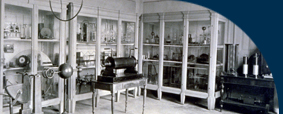 |
Bourbouze's electromotor |
 |
Elettromotore di Bourbouze |
| Subject: electromagnetism/magneto-mechanical motor model |
Settore: elettromagnetismo/modello di motore magnetomeccanico |
| Number of catalogue: 35 |
Numero di inventario: 35 |
| engraved on the brass beam: "G. Giovagnoli Sansepolcro 1858" |
Sul bilanciere d'ottone: "G. Giovagnoli Sansepolcro 1858" [inciso] |
| 1858 |
Periodo di costruzione: 1858 |
| Walnut, brass, iron, plastic, silk, bone |
Materiali utilizzati: Noce, ottone, ferro, plastica, seta, osso |
| 388 X 155 X 300 [mm] |
Dimensioni: 388 x 155 x 300 [mm] |
| |
|
It is evident from an engraved inscription that the instrument was made in 1858 by the mechanician G. Giovagnoli, who was one of Serpieri's disciples and the owner of a mechanical workshop in Sansepolcro. The machine is an historical reproduction of a magneto-mechanical motor proposed by the Parisian instrument-maker Jean Bourbouze [1] (1826-1889). This device, which is of fine workmanship and has fine trimmings, is supplied by continuous current and transforms electric energy into mechanical energy. |
Da una incisione l'apparato risulta costruito nel 1858 dal meccanico G. Giovagnoli, allievo del Serpieri e titolare di una officina meccanica artigianale in Sansepolcro. L'apparecchio è la riproduzione storica di un motore magnetomeccanico ideato dal costruttore e preparatore di laboratorio parigino Jean Borbouze [1] (1826-1889). Alimentato in corrente continua, questo dispositivo, di pregevole fattura e molto curato nelle rifiniture, trasforma l'energia elettrica in energia meccanica. |
| |
|
Description: The whole machine is mounted in a carefully carved walnut frame: Upon it, two pairs of ferromagnetic cylinders are free to slide within two pairs of vertical solenoids. The small cylinders, in each pair, are connected in such a way that they form a sort of mobile keeper of a magnetic circuit, which is made of a second pair of ferromagnetic (fixed) cylinders, which are inside the pair of solenoids. The pairs of mobile cylinders are mechanically attached to a brass beam that transmits the alternating linear movement of the pistons to a connecting rod system the moves a wheel with six spokes. The wheel activates a cam, the rotation of which in turn activates a horizontally oscillating swich. |
Descrizione: l'intero corpo macchina è montato su un telaio in noce ben lavorato. Su di esso due coppie di cilindri ferromagnetici sono libere di scorrere dentro due coppie di solenoidi verticali. I cilindretti, in ogni coppia, sono collegati in modo da formare una sorta di ancoretta mobile di un circuito magnetico, costituito da una seconda coppia di cilindri ferromagnetici (fissi) interni alla coppia di solenoidi. Le coppie di cilindri mobili sono collegate meccanicamente ad un bilanciere che trasmette i movimenti rettilinei-alternati dei pistoni ad un sistema biella-manovella che muove una ruota a sei raggi la cui rotazione trascina un eccentrico. La rotazione di quest'ultimo comanda un deviatore di contatti striscianti. |
| |
|
Function: When the electrical current passes through the pair of solenoids, the mobile cylinders are attracted towards the fixed cylinders. When a pair of cylinders lowered, the other pair in the solenoids through which the current does not run is elevated, because the two pairs of mobile cylinders are mechanically connected. The movement of the cylinders is transmitted through an arm and cam system to a six-spoke wheel, the rotation of which activates another cam. The rotation of this cam controls a switch with sliding contact that closes and opens alternatively the supply circuits of the two pairs of electromagnets. |
Funzionamento: quando la coppia di solenoidi è percorsa da una corrente elettrica, i cilindri mobili vengono attratti verso quelli fissi. All'abbassamento di una coppia di cilindri corrisponde l'innalzamento dell'altra nei solenoidi non percorsi da corrente. Il moto trasmesso alla ruota mette in movimento, mediante l'eccentrico, il deviatore a contatti striscianti che chiude ed apre alternativamente i circuiti di alimentazione delle due coppie di elettromagneti. |
| |
|
Bibliography: Privat Deschanel [1877], part III, pp. 711-712; Bernardini, Grianti, Mantovani, Vetrano [1992], pp.45-51. |
Bibliografia: Privat Deschanel [1877], Part. III, pp. 711-712; Bernardini, Grianti, Mantovani, Vetrano [1992], pp. 45-51. |
| |
|
[1] From 1849 physics laboratory assistant at Sorbonne University and subsequently (1862) assistant in charge of didactic experimentation in the School of Pharmacy. |
[1] Dal 1849 preparatore di fisica alla Sorbona e successivamente (1862), preparatore incaricato delle esercitazioni alla Scuola di Farmacia. |

